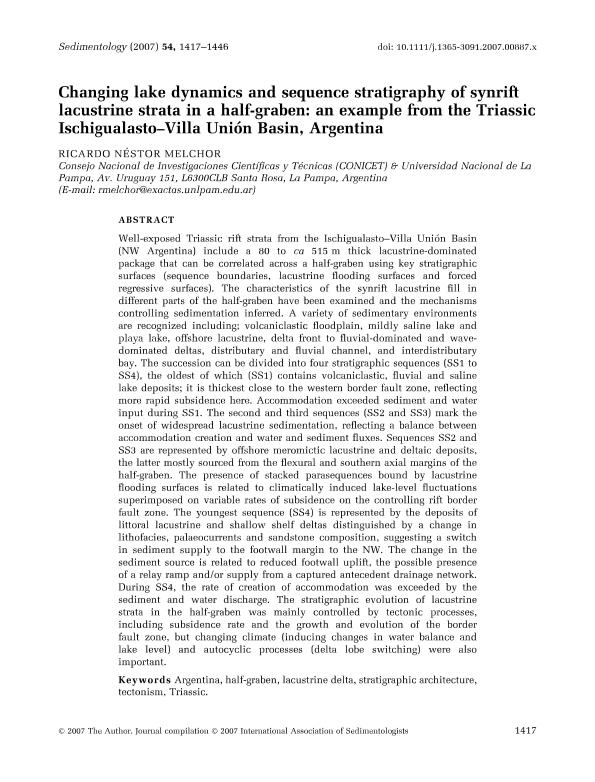Artículo
Changing lake dynamics and sequence stratigraphy of synrift lacustrine strata in a half-graben: An example from the Triassic Ischigualasto-Villa Unión Basin, Argentina
Fecha de publicación:
12/2007
Editorial:
Wiley Blackwell Publishing, Inc
Revista:
Sedimentology
ISSN:
0037-0746
Idioma:
Inglés
Tipo de recurso:
Artículo publicado
Clasificación temática:
Resumen
Well-exposed Triassic rift strata from the Ischigualasto-Villa Unión Basin (NW Argentina) include a 80 to ca 515 m thick lacustrine-dominated package that can be correlated across a half-graben using key stratigraphic surfaces (sequence boundaries, lacustrine flooding surfaces and forced regressive surfaces). The characteristics of the synrift lacustrine fill in different parts of the half-graben have been examined and the mechanisms controlling sedimentation inferred. A variety of sedimentary environments are recognized including; volcaniclastic floodplain, mildly saline lake and playa lake, offshore lacustrine, delta front to fluvial-dominated and wave-dominated deltas, distributary and fluvial channel, and interdistributary bay. The succession can be divided into four stratigraphic sequences (SS1 to SS4), the oldest of which (SS1) contains volcaniclastic, fluvial and saline lake deposits; it is thickest close to the western border fault zone, reflecting more rapid subsidence here. Accommodation exceeded sediment and water input during SS1. The second and third sequences (SS2 and SS3) mark the onset of widespread lacustrine sedimentation, reflecting a balance between accommodation creation and water and sediment fluxes. Sequences SS2 and SS3 are represented by offshore meromictic lacustrine and deltaic deposits, the latter mostly sourced from the flexural and southern axial margins of the half-graben. The presence of stacked parasequences bound by lacustrine flooding surfaces is related to climatically induced lake-level fluctuations superimposed on variable rates of subsidence on the controlling rift border fault zone. The youngest sequence (SS4) is represented by the deposits of littoral lacustrine and shallow shelf deltas distinguished by a change in lithofacies, palaeocurrents and sandstone composition, suggesting a switch in sediment supply to the footwall margin to the NW. The change in the sediment source is related to reduced footwall uplift, the possible presence of a relay ramp and/or supply from a captured antecedent drainage network. During SS4, the rate of creation of accommodation was exceeded by the sediment and water discharge. The stratigraphic evolution of lacustrine strata in the half-graben was mainly controlled by tectonic processes, including subsidence rate and the growth and evolution of the border fault zone, but changing climate (inducing changes in water balance and lake level) and autocyclic processes (delta lobe switching) were also important.
Archivos asociados
Licencia
Identificadores
Colecciones
Articulos(INCITAP)
Articulos de INST.D/CS D/L/TIERRA Y AMBIENTALES D/L/PAMPA
Articulos de INST.D/CS D/L/TIERRA Y AMBIENTALES D/L/PAMPA
Citación
Melchor, Ricardo Nestor; Changing lake dynamics and sequence stratigraphy of synrift lacustrine strata in a half-graben: An example from the Triassic Ischigualasto-Villa Unión Basin, Argentina; Wiley Blackwell Publishing, Inc; Sedimentology; 54; 6; 12-2007; 1417-1446
Compartir
Altmétricas




